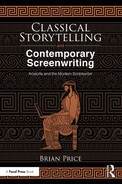Fifteen
Structure
“As for the story, whether the poet takes it ready made or constructs it for himself, he should first sketch its general outline, and then fill in the episodes and amplify in detail.”
(Poetics, Part XVII)
As we’ve seen, a good story is made up of the necessary and connected events that pose a dramatic question at the beginning and answer it at the end, that give a hero a dramatizable objective, chronicle his pursuit of it, and ultimately resolve whether or not it’s achieved. And we’ve seen that those same necessary and connected events also help produce a hero’s change of fortune, getting him from who he is at Point A to who he’s become at Point Z.
The STRUCTURE of a story, plain and simple, is the arrangement of those necessary and connected events.
And according to Aristotle, if you examine the stories that have stood the test of time, that we venerate as worthwhile, commercially or artistically, because they successfully accomplish the important goals of storytelling, the proper placement of those events follows observable patterns.
In fact, one could argue that the most significant contribution Aristotle makes in his Poetics, is to detail precisely what the proper structure of a good story well told is.
However, before we can explore just what that structure looks like, we must first absorb Aristotle’s advice as to how to go about crafting it, indeed, the very way in which one goes about constructing a screenplay.
So look again at the quote that begins this chapter and let it sink in.
Go on, I’ll wait…
And ladies and gentlemen, there you have it once more, how to write a screenplay in one simple sentence. Don’t forget to thank Aristotle when you accept your Oscar.
Actually, let’s examine this admonition a little closer. And since it’s so fundamental to our process, let’s proceed by repeating those crucial words:
“First sketch its general outline, and then fill in the episodes and amplify in detail.”
(Poetics, Part XVII)
That is exactly how one crafts a plot, by first determining its general shape, and then filling in the finer details. And be warned, this is far from the last time you’ll hear this important advice.
Aristotle goes on to give examples of this process, describing first the story of Iphigenia:
“A young girl is about to be sacrificed but disappears mysteriously. She is transported to another country where she becomes a priestess who performs sacrifices. One day she is about to perform one on a stranger who reveals that this fate was destined since it also befell his sister. She realizes it is her brother and he’s saved.”
(Poetics, Part XVII)
Then he does the same with The Odyssey:
“A certain man is absent from home, desolate, for many years, jealously watched by Poseidon. Meanwhile, at home his estate is being squandered by his wife’s suitors who plot against his son. At length, tempest-tossed, he himself arrives, attacks the suitors, and is himself preserved while he destroys them.”
(Poetics, Part XVII)
Recognize what Aristotle is doing here? Yeah, he’s essentially giving us LOGLINES. In just a few sentences, he’s describing these two stories by giving us the plot’s biggest events while leaving out the myriad of moments in between.
Notice also that he’s intentionally left out the proper names. As he insists, this isn’t history, it’s drama, so the stories are first set out in universal terms. These events could be happening to anyone anywhere, to Iphigenia or Odysseus, or to anyone else with similar traits and experiences, even to the readers and viewers themselves.
This then, for Aristotle, is the first step of crafting the plot, determining those biggest events, the reversals and revelations that give the story its general shape. A girl’s escape, her priesthood, the arrival of the stranger, the recognition of her brother, and then the resulting reunion. A man’s confinement, the suitors’ scheme, the voyage home, the confrontation, and the final outcome.
Once these big moments are established, all that’s left is to fill in the smaller events in between. Or as Aristotle puts it:
And guess what. That is exactly how we craft the plot of our screenplay. So it is Aristotle’s Guiding Precept #11:
THE PROPER WAY TO CONSTRUCT A PLOT IS TO GO FROM THE GENERAL TO THE SPECIFIC, STARTING FROM THE BIGGEST MOMENTS OF REVERSAL AND RECOGNITION AND THEN FILLING IN THE EVENTS THAT CONNECT THEM.
If you learn one thing from this book, it’s that when we’re writing a screenplay, we don’t start typing at page one and then write straight through until we get to the end.
Instead, we start with the general shape, with the biggest events that define that shape. Then we fill in the smaller events that bridge them. Then the even smaller ones between those. Until we’ve mapped out the entire plot, moment by moment. Only then do we start writing the actual pages, translating each of those moments, big and small, into scenes of dialogue and description.
In other words, the process of classical storytelling that Aristotle laid out in his Poetics 2,500 years ago still remains our process when crafting a modern screenplay today. We start with the general outline, fill in the episodes, then amplify in detail.
And now that we know where to start, mapping out the overall shape of the story, let’s explore what Aristotle has to say about choosing the biggest moments that define that shape, and where, precisely, to put them.
